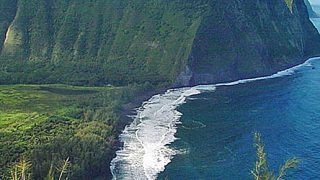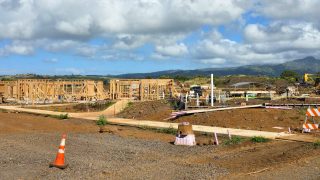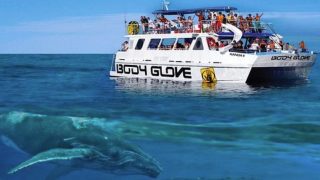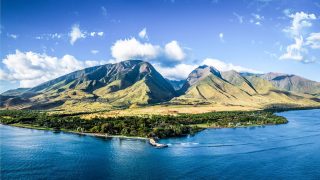Boasting premium shrimp production right in the heart of Kekaha on the Garden Island, Kauai Shrimp has earned a reputation as a staple in Hawaii’s aquaculture success. It’s also featured on many restaurant menus around the islands.
But beyond its glossy image lies a bubbling controversy over pollution and regulatory oversight that has caught the attention of residents, environmental groups, and Hawaii travelers. As the state debates the renewal of its pollutant discharge permit, questions about sustainability, accountability, and the delicate balance of Hawaii’s ecosystems are surfacing like never before.
There is a growing concern over pollution at Major’s Bay Beach.
Kauai Shrimp’s effluent discharge into canals flowing into Major’s Bay, one of Kauai’s pristine coastal areas on the island’s West Side, has sparked widespread outcry. The Surfrider Foundation’s Kauai Chapter has long expressed concerns about the impact on marine ecosystems, surfers, and anglers who rely on these waters. Dead fish in drainage ditches leading to the ocean are becoming a recurring sight, with pollution threatening the health of coral reefs and the broader marine environment.
The Hawaii Department of Health’s draft permit proposes increasing Kauai Shrimp’s allowable wastewater discharge from five million to 20 million gallons per day, an alarming figure for those who frequent this coastline. “We just don’t want them to pollute while they’re doing business,” said one Surfrider member during a recent public forum, echoing widespread concerns about the lack of meaningful pollution prevention measures.
Residents call for stronger oversight of Kauai Shrimp.
The Department of Health has faced criticism for failing to regulate Vibrio bacteria, which thrives in brackish ocean waters. This omission raises significant concerns about public safety. “Why isn’t the DOH setting standards for bacteria that could harm surfers and swimmers?” asked Tim, a frequent visitor to Major’s Bay who closely follows Hawaii’s environmental policies. This lack of monitoring and regulation fuels fears that the permit process prioritizes industry convenience over environmental health.
Reader comments on Beat of Hawaii have also pointed to the inadequate enforcement of existing water quality rules. Lisa wrote, “If the shrimp farm gets to expand wastewater discharge without strict limits, it sends the wrong message about protecting Hawaii’s ecosystems.”
Others have questioned why permits for interconnected polluters, like the Agribusiness Development Corporation, remain uncoordinated, leaving room for blame-shifting when fish kills occur.
Kauai Shrimp defends their practices.
Kauai Shrimp, which is now owned by Oahu-based Aloun Farms, defends its practices as environmentally conscious and aligned with sustainable farming principles. The farm emphasizes that its shrimp are raised without antibiotics or chemicals, claiming rigorous testing meets federal and state requirements.
A statement from Aloun Farms promised to retain local jobs and explore aquaculture opportunities on unused farmland. However, not all are convinced. “This is about more than jobs—it’s about ensuring future generations can enjoy the beaches, clean waters, and marine life Hawaii is known for,” wrote Sarah, a Kauai resident advocating for stricter regulations.
Surfrider Foundation asks for accountability.
The Surfrider Foundation has led in challenging Kauai Shrimp’s proposed permit renewal, issuing detailed public comments and requesting a hearing. The organization’s calls include consolidating the shrimp farm’s permit with those of other nearby operations to ensure coordinated oversight. This effort aims to eliminate gaps in accountability, reduce pollution levels, and proactively address incidents like mass fish kills.
Some residents remain hopeful for compromise. “It’s not about shutting down the farm—it’s about doing it right,” shared Daniel, a sustainable aquaculture supporter who frequents the beaches in question. Surfrider echoes this sentiment, stressing the need for stronger prevention measures, unlined canal improvements, and proper water quality monitoring.
What this means for Hawaii travelers.
Kauai’s unspoiled beauty and pristine waters are key attractions for visitors. However, this controversy is a stark reminder that Hawaii’s natural resources require vigilant stewardship. Surfers and ocean enthusiasts are increasingly cautious about entering polluted waters, which poses a long-term threat to Kauai’s tourism-dependent economy.
The pending decision on Kauai Shrimp’s permit renewal isn’t just a local issue. It raises broader questions about balancing industry needs with environmental preservation—a theme central to Hawaii’s future. As Lisa put it, “Hawaii’s economy depends on clean water as much as it does on sustainable farming.”
Beat of Hawaii photo at Kekaha Beach.
Surfrider-Comments-Sunrise-Capital_2022.11.18Get Breaking Hawaii Travel News







This sounds like the Hawaii environmental health agency and the EPA haven’t done their part. They could require stricter wastewater release standards from Kauai Shrimp so that the water dumped into Majors Bay canal is a lot cleaner than it is a present. This would mean that Kauai Shrimp would need to put additional safeguards and cleaning methods in place prior to their effluent discharge. Of course, this would drive the cost of Kauai Shrimp up. So what is more important: the enviroment or the price of shrimp? It’s time to make a decision!
Nothing like wild caught Gulf of Mexico shrimp IMO, fresh out of the net, firm and snappy. Boiled up with corn, onions, smoked sausage, and new red potatoes. Crab too if your traps are panning out. Few dozen oysters on the side w lemon and Tabasco. Maybe some mignonette sauce for the more traditionally inclined… Plenty of cold adult beverages as well!
Cheers!
Thanks for this piece. And so important given that your audience reaches beyond the islands. The thousands of tourists who visit Kauai each year and love the island need be aware of the many environmental concerns —from untold pesticide spraying ( from the usual suspects, Dupont, Dow, Pioneer) to polluted beaches from thousands of cesspools, the near extinction of many species of birds and untold concerns from military —from radar to research labs. Maybe there should be a required warning at all restaurants regarding Kauai’s homegrown shrimp factory. Eat at your own risk.
Where are the facts. Of course no say nothing about the Base. Could they be ones polluting. So the ponds that are giving life are killing fish with the discharge? Surfing over food and workers making a living. WHY doesn’t SRF check out the Base that would be more likely. Why SRF pick on the little guy, make no sense to me
I have the original copy
Saved,from When,Joann yukimura wouldnt sign
In 1990!I wrote the book
Me,Your polluted west side,you will freak out
And finally someone
Is in deep – – – -!
Tim Surfrider Foundation good Job
I used to think shrimp was healthy to eat and then someone stated they are extremely high in Cholesterol. Checked the bag and was shocked. I know you have to de vein the black fecal matter out of them before cooking. The only other contaminant a shrimp has is the shell and parts other than the tail. On the coastal area’s where I’m from the shell portion is sold to fertilizer companies. Waste water with bacteria must be from spoiled crustacian parts and such. Thank you BOH for not pointing the finger at the tourist for creating this problem. I wonder if the oyster farms that you get the black and purple pearls that are sold at the marketplace have the same issues.
Just wanted to say Mahalo for this insightful article. The west side area of Kauai doesn’t get much coverage and so I think that maybe certain conditions have been able to exist without too much oversight. This is unfortunate for the reasons mentioned (pollution runoff, reef degradation, etc) and I am glad that it is being brought to the attention of everyone who reads your Beat. Mahalo Rob+Jeff for everything that you do and keeping us informed.
Hi Debra.
Thank you! 😉
Aloha.
Major’s is such a special spot for surfers and families. It’s a shame that discharge is allowed to flow into these waters without oversight. It feels like the Navy’s presence here would also demand higher standards.
I’ve noticed fewer people surfing at Major’s lately, and I wonder if it’s because of the water quality concerns.
I’ve lived near in Kehaha for years. But recently, the water feels different, and there’s a smell that wasn’t there before.
As someone who regularly surfs at Major’s Bay, it’s heartbreaking to see dead fish in the water and know we’re potentially exposed to harmful bacteria. This isn’t just an environmental issue—it’s about public health and safety. Thanks for bringing it up.
Yes, what is the pollution being spilled from shrimp and how many people actually use this area, not that we want pollution anywhere but I wonder if this Even comes close to what drains onto Kalapaki bay?
Nowhere in this entire article are there any facts to support the pollution claims.